Xi'an, Terracotta Warriors, Acrobats - Wednesday, July 11, 2001
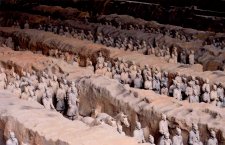 We got up early and checked out of the hotel. We had a great breakfast, buffet-style,
that included french toast and bacon (American bacon). We headed off to the terracotta
warrios, about an hour east of town. We arrived at 9:00 a.m., half an hour after the
place opens. It gets very crowded. We headed straight to the pits of warriors, over
the objections of our Chinese guide who wanted us to see the movie first so that we
could properly appreciate the warriors when we saw them. The problem with that plan is
that by the time you get to the warriors you can barely see them because it is so crowded.
We got up early and checked out of the hotel. We had a great breakfast, buffet-style,
that included french toast and bacon (American bacon). We headed off to the terracotta
warrios, about an hour east of town. We arrived at 9:00 a.m., half an hour after the
place opens. It gets very crowded. We headed straight to the pits of warriors, over
the objections of our Chinese guide who wanted us to see the movie first so that we
could properly appreciate the warriors when we saw them. The problem with that plan is
that by the time you get to the warriors you can barely see them because it is so crowded.
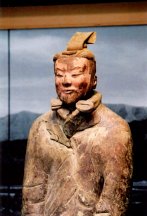 The warriors are really cool. They mass produced the feet and legs (which are solid),
and the torsos and arms (which are hollow). There are several varieties of each, so
all of the soldiers don't look the same. In addition, there are numerous different
types of soldiers, archers, pikemen, officers, etc. The hands were different depending
what type of weapon the warrior was holding. Finally, each head is different. It is
thought that many were likenesses of the people who carved them.
The warriors are really cool. They mass produced the feet and legs (which are solid),
and the torsos and arms (which are hollow). There are several varieties of each, so
all of the soldiers don't look the same. In addition, there are numerous different
types of soldiers, archers, pikemen, officers, etc. The hands were different depending
what type of weapon the warrior was holding. Finally, each head is different. It is
thought that many were likenesses of the people who carved them.
The warriors were found a couple of kilometers east of the Emperor's tomb, which looks
like a low hill and has not been excavated. There are three sets of pits that have
been found so far, but only a small portion has been excavated. The warriors are
colorfully painted, but the paint fades within minutes of being exposed to the air and
light. The excavators have not figured out how to prevent this yet.
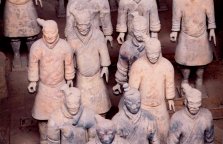 The warriors are in trenches that used to be covered with a roof of some kind. All
of this was then covered with dirt. The figures are foot soldiers, archers (some
standing and some kneeling), cavalry, and charioteers. There are also some officers,
generals, and horses and chariots. Originally, they held wooden weapons, but those
were mostly destroyed over time. Many of the figures had to be put back together or
repaired.
The warriors are in trenches that used to be covered with a roof of some kind. All
of this was then covered with dirt. The figures are foot soldiers, archers (some
standing and some kneeling), cavalry, and charioteers. There are also some officers,
generals, and horses and chariots. Originally, they held wooden weapons, but those
were mostly destroyed over time. Many of the figures had to be put back together or
repaired.
After going through the three pits we went to see the movie, which was in a 360°
theater. Much of the movie was on all sides, but some portions of the film took up
only a third of the screen and were shown on several sides. Occasionally, each screen
would have a different picture or scene.
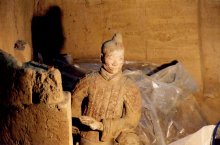 The movie was interesting and gave some history about finding the warriors. The movie
also provided information about the Emperor who brought together the seven kingdoms
into what is modern-day China and had the terracotta warriors created to protect his
tomb. There was also a section on how the Emperor's successor attempted to destroy
the warriors and sack the tomb. Finally, there were a couple of pieces about how the
warriors were created and how the excavators have preserved and restored the warriors.
The movie was interesting and gave some history about finding the warriors. The movie
also provided information about the Emperor who brought together the seven kingdoms
into what is modern-day China and had the terracotta warriors created to protect his
tomb. There was also a section on how the Emperor's successor attempted to destroy
the warriors and sack the tomb. Finally, there were a couple of pieces about how the
warriors were created and how the excavators have preserved and restored the warriors.
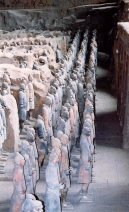 According to Ian, they run the film in whatever language (English or Chinese) that
they feel like for each performance. In theory, this is based on the composition of
the audience. At least that is the theory. Ours was in English, although you couldn't
really hear the sound, so it isn't as if it really mattered which language was
playing. Some German tourists taped the whole movie on a digital camcorder. Odd.
According to Ian, they run the film in whatever language (English or Chinese) that
they feel like for each performance. In theory, this is based on the composition of
the audience. At least that is the theory. Ours was in English, although you couldn't
really hear the sound, so it isn't as if it really mattered which language was
playing. Some German tourists taped the whole movie on a digital camcorder. Odd.
Next, we headed over to the museum to see some more artifacts and some prime examples
of terracotta warriors. Another little tid bit. In addition to the warriors, the
Emperor was buried with all of the artifacts, and people, surrounding him when he was
alive. Ian suspects that this was not mentioned in the contract -- by the way, when
you are finished building the tomb, you'll be buried in it. You gotta watch out for
that fine print! As in Egypt, they started work on an Emperor's tomb as soon as he
took power. Many emperors attempted to prolong their lives through elixers and
other means.
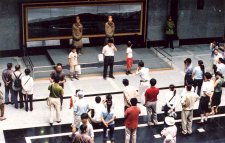 We left the terracotta warriors and headed off for some lunch, and shopping. The
vendors are kept out of the area with the warriors, and are prohibited from going
up to the tourists as they walk to and from the site. Unless you approach them,
they are supposed to leave you alone.
We left the terracotta warriors and headed off for some lunch, and shopping. The
vendors are kept out of the area with the warriors, and are prohibited from going
up to the tourists as they walk to and from the site. Unless you approach them,
they are supposed to leave you alone.
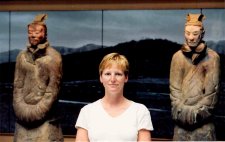 Anne and Sally were both interested in terracotta warriors, and I was interested
in getting some ice cream. We all achieved our desires. I also checked out some
masks at one shop, but I didn't really see anything I liked. So, we headed over
to the restaurant but Ian had a disagreement over the pricing, so we went to the
place next door. We ordered noodles with beef for everyone else, and meat-filled
dumplings for me. the noodles came out and they informed me that they were sold
out of dumplings. Since I had been unable to even procure any water, I headed out
to do some more shopping instead.
Anne and Sally were both interested in terracotta warriors, and I was interested
in getting some ice cream. We all achieved our desires. I also checked out some
masks at one shop, but I didn't really see anything I liked. So, we headed over
to the restaurant but Ian had a disagreement over the pricing, so we went to the
place next door. We ordered noodles with beef for everyone else, and meat-filled
dumplings for me. the noodles came out and they informed me that they were sold
out of dumplings. Since I had been unable to even procure any water, I headed out
to do some more shopping instead.
 I went to a store next to the one in which I had seen the masks and saw a couple
of masks that I liked. They started at ¥150 ($18.50), discounted just for me to
¥120 ($15.00). I asked if they had any others, but the others were all bigger.
We were now at ¥80. When asked for a price I suggested ¥15. I stuck with my
price as theirs dropped to ¥60, ¥50, ¥40, and eventually ¥20. I maintained my
¥15, but they did not seem inclined to drop further, so I walked back to the
restaurant. They made no further entreaties as I left. The others thought I
should go with the ¥20 price ($2.50). So, I went back and tried two for ¥35, but
we ended up at two for ¥40.
I went to a store next to the one in which I had seen the masks and saw a couple
of masks that I liked. They started at ¥150 ($18.50), discounted just for me to
¥120 ($15.00). I asked if they had any others, but the others were all bigger.
We were now at ¥80. When asked for a price I suggested ¥15. I stuck with my
price as theirs dropped to ¥60, ¥50, ¥40, and eventually ¥20. I maintained my
¥15, but they did not seem inclined to drop further, so I walked back to the
restaurant. They made no further entreaties as I left. The others thought I
should go with the ¥20 price ($2.50). So, I went back and tried two for ¥35, but
we ended up at two for ¥40.
 We picked up some water on the way to the bus and then headed out to the airport.
As with all travel in China, the bus to the airport took about an hour and the
flight to Shanghai took about an hour. the landing in Shanghai was relatively
smooth, a rarity in China.
We picked up some water on the way to the bus and then headed out to the airport.
As with all travel in China, the bus to the airport took about an hour and the
flight to Shanghai took about an hour. the landing in Shanghai was relatively
smooth, a rarity in China.
We arrived in Shanghai and found our local guide and took a minibus directly to
the restaurant. The restaurant was nice except that the chopsticks were think and
pastic. This made it difficult to pick up slippery food. We had some thousand-year
eggs, which are buried in the ground instead of being cooked. The whites turn a
smoky brown, which is surprisingly unappealing.
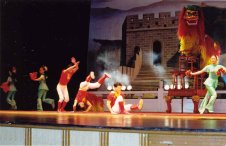 They serves us rice early in the meal, a sure sign that they cater to foreigners.
Most Westerners eat rice with their meal. In China it is considered polite to
bring the best dishes first so that your guests fill up on good food instead of
rice and other inexpensive dishes. It is polite, as the diner, to leave some
food to show that your host fed you enough.
They serves us rice early in the meal, a sure sign that they cater to foreigners.
Most Westerners eat rice with their meal. In China it is considered polite to
bring the best dishes first so that your guests fill up on good food instead of
rice and other inexpensive dishes. It is polite, as the diner, to leave some
food to show that your host fed you enough.
After dinner we headed over to see the acrobats. It was not very crowded in the
auditorium, so Ian and I snuck up front to take pictures. The acrobats were
really good, and they did tricks with bicycles, balancing chairs, juggling, jumping
through hoops, contortionists, and ended with a guy on a motorcycle riding around
inside a large metal ball. He was joined by another guy on a motorcycle, and then
a third and finally a fourth. All four zoomed around inside the ball, then one
would beep his horn and they would all change speed and direction and do loops in
a different direction. It was incredible.
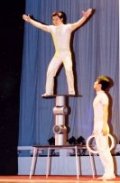
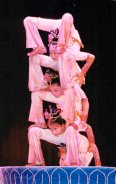

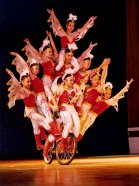
After the show we headed to our hotel, which was really nice. We were on the 24th
floor, and had a nice view of the city. Interestingly enough, you could open the
windows up enough to get out.
| Home | China Journal |
© 2001 John Eisinger. All rights reserved
Please report any problems to me.
 We got up early and checked out of the hotel. We had a great breakfast, buffet-style,
that included french toast and bacon (American bacon). We headed off to the terracotta
warrios, about an hour east of town. We arrived at 9:00 a.m., half an hour after the
place opens. It gets very crowded. We headed straight to the pits of warriors, over
the objections of our Chinese guide who wanted us to see the movie first so that we
could properly appreciate the warriors when we saw them. The problem with that plan is
that by the time you get to the warriors you can barely see them because it is so crowded.
We got up early and checked out of the hotel. We had a great breakfast, buffet-style,
that included french toast and bacon (American bacon). We headed off to the terracotta
warrios, about an hour east of town. We arrived at 9:00 a.m., half an hour after the
place opens. It gets very crowded. We headed straight to the pits of warriors, over
the objections of our Chinese guide who wanted us to see the movie first so that we
could properly appreciate the warriors when we saw them. The problem with that plan is
that by the time you get to the warriors you can barely see them because it is so crowded.











